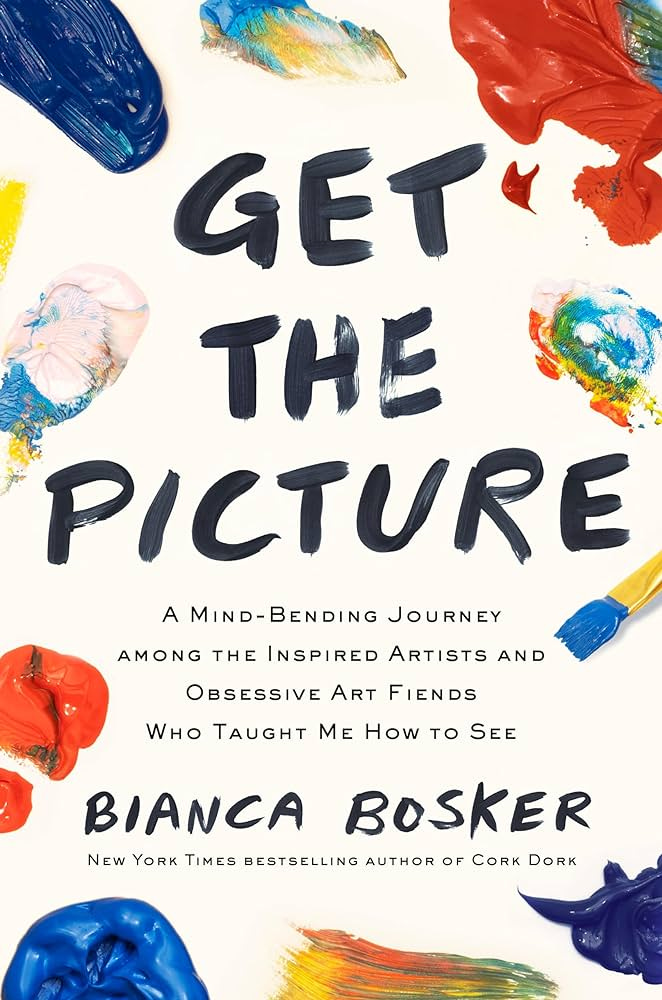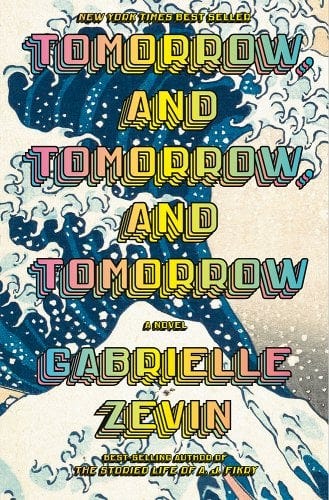Bookworm: March 2024
'Book Lovers,' 'Get the Picture,' 'Feeding Ghosts,' 'Tomorrow, and Tomorrow, and Tomorrow,' "Caste'
This post contains an affiliate link or links. If you use a link to buy a book, I may earn a small commission. You can find all the books that have been featured in this newsletter in my Bookshop store.
Happy Easter Sunday to those who celebrate it!
This month I’m doing something a little different with my five picks: I’ve got blurbs on a couple of books from an event where the authors spoke.
Table of contents
Romance: “Book Lovers,” by Emily Henry
Art: “Get the Picture,” by Bianca Bosker
Graphic memoir: “Feeding Ghosts,” by Tessa Hulls
Fiction: “Tomorrow, and Tomorrow, and Tomorrow,” by Gabrielle Zevin
Sociology: “Caste: The Origin of Our Discontents,” by Isabelle Wilkerson
“Book Lovers”
No trip to the library is complete without a quick perusal of the “Lucky Day” shelf, where you can “win” a title that usually has a long wait list. My latest win was Emily Henry’s bibliophile romance “Book Lovers,” which casts a literary agent and a book editor in Manhattan as the stars of “will they or won’t they?”
Nora has a reputation as The Shark for her utter devotion to her career, the one controllable constant in her life. Charlie, when we and Nora meet him, seems equally hard-charging and heartless, not her type at all. They suffer through a disastrous business lunch and part ways for two years before Henry throws them together again in a tiny North Carolina town that’s the polar opposite of their beloved New York City.
This is a smart, snappy book, replete with firecracker dialogue. As the one-liners fly, so do the sparks. Best of all, “Book Lovers” is also a love letter to books and the people who can’t live without them. Nora and Charlie cross the romantic Rubicon by, of all things, editing a book together. Nothing says love like a shared Google Doc.
“Get the Picture: A Mind-Bending Journey Among the Inspired Artists and Obsessive Art Fiends Who Taught Me How to See”
Until this month, I hadn’t heard of the journalist Bianca Bosker. Then there she was onstage at an event I was attending, talking about her new book, “Get the Picture,” and how it fundamentally rewired her brain in regard to art.
Before Bosker began the reporting for her book, she said, she found contemporary art intimidating, a rarefied pastime for those who actually understood the aesthetic language of “limp vegetables” and used obscure polysyllabic words to talk about finger painting. Then she began haunting galleries and even took a job in one. She was a security guard for a time, deliberately standing in front of wall text to force visitors to engage with the actual art. And — in an anecdote that had me alternately cringing and laughing — she attended an exhibit opening where she found herself intimately intertwined with a “butt influencer.” It is a sign of the times, perhaps, that one can become a social media star by posting many images of posteriors. Butt is it art?
Bosker’s answer: yes. She emerged from her immersion in the art world with a new perspective. Now she can’t live without art; she finds it fundamental to her very being and to our humanity.
I’ve got the book on hold at the library. Meanwhile, my spouse and I sent a copy to his 84-year-old mother, who’s been an artist her whole adult life. She said she’s loving it.
You can hear Bianca Bosker talk about “Get the Picture” on an upcoming Live Wire Radio episode.
“Feeding Ghosts”
It’s always fun to hear about a book through a personal connection. That was the case with “Feeding Ghosts.” A friend knew the author, Tessa Hulls, and mentioned her upcoming appearance in our area (the same event where Bianca Bosker spoke).
Hulls spent nearly a decade on this book, a family memoir told as graphic literature, and doing so was such an undertaking that she said she won’t be doing another book. As The New York Times wrote, the project required her to learn history, learn Chinese and learn to draw comics. Hulls said she couldn’t have told the story any other way.
It’s a dramatic tale that lends itself well to visuals, to be sure. Hulls’ grandmother was a Shanghai journalist who had an affair with a Swiss diplomat that resulted in a child, Hulls’ mother. Meanwhile, Chiang Kai-shek’s Nationalist party and Mao Zedong’s Communist party were warring for control of China. When the Communists prevailed, Hulls’ grandmother joined the out-migration, fleeing to Hong Kong with her daughter. The girl’s biracial heritage gave her entree to a school where she learned English. Ultimately, mother and daughter made their way to California, where Hulls grew up. Her childhood was shaped by a grandmother who’d developed mental illness and a mother who was constantly guarded — and so she left, embarking on years of self-imposed exile from her family.
What brought her back was a book: her grandmother’s memoir. It had been a hit in Hong Kong, but Hulls didn’t know Chinese at the time. She commissioned an English translation and was surprised by what she read. That led to “Feeding Ghosts,” which Hulls told the Times was mostly “about looking at the collision of conflicting narratives” within her family. Those narratives still don’t always agree, she said, but now she and her mother know how to make space for those conflicts.
You can hear Tessa Hulls talk about “Feeding Ghosts” on an upcoming Live Wire Radio episode.
“Tomorrow, and Tomorrow, and Tomorrow”
I initially wasn’t sure what to make of my library’s 2024 Everybody Reads selection: a novel about video game designers? But this program has a great track record, so I gamely (heh) picked up my complimentary copy of Gabrielle Zevin’s “Tomorrow, and Tomorrow, and Tomorrow.”
So glad I did. While one could describe this novel as a story about three friends who design and sell video games over several decades, that would be like saying Shakespeare’s “Macbeth” is about a guy who kills another guy to get his job. Like a good video game, “Tomorrow” engaged me on multiple levels:
Friendship, particularly the intense connections formed during impressionable times (lonely hours in a hospital, the first year of college).
Creativity: Zevin leads us through the process of designing and creating a game, with what I thought was just the right amount of detail — enough to feel as if I was getting an insider’s peek behind the scenes, but not so much that I got overwhelmed or bored.
Diversity, or lack thereof, in the video game industry: It’s dominated by white men, and our central trio consists of a Jewish woman, an Asian man and a biracial man with a disability. Zevin is herself biracial, with a white father and Korean mother, and she integrates that experience throughout the novel.
Our one wild and precious life: The book’s title comes from the Scottish play I just referenced, in which the antihero delivers one of Shakespeare’s most acclaimed soliloquies. In video games, there’s always another tomorrow; you’re dead only until you restart, to strut across the screen again. But what does it signify?
Tomorrow, and tomorrow, and tomorrow,
Creeps in this petty pace from day to day,
To the last syllable of recorded time;
And all our yesterdays have lighted fools
The way to dusty death. Out, out, brief candle!
Life's but a walking shadow, a poor player,
That struts and frets his hour upon the stage,
And then is heard no more. It is a tale
Told by an idiot, full of sound and fury,
Signifying nothing.
“Caste: The Origin of Our Discontents”
I read “Caste” shortly after it came out in 2020, and was delighted to have a chance to revisit it courtesy of a book club at work.
Author Isabel Wilkerson (“The Warmth of Other Suns”) uses three caste-based societies, the United States, India and Nazi Germany, in developing her premise: Race is the skin, caste is the skeleton. If we focus on addressing racial inequities without also addressing the underlying issues of caste, we won’t get very far. She blends scholarship and personal experience — hers and others — as she defines and explores what she calls eight pillars of caste and their consequences.
What I remembered most about the book after the first reading was Wilkerson’s research on how the Nazi regime studied the U.S. caste system to develop their own, and how they considered some aspects of ours too extreme to adopt (such as the “one-drop rule,” under which anyone with any African heritage, no matter how distant, was labeled Black). After my second reading, I’m left thinking: Isn’t a genocide perpetrated over centuries with chattel slavery, systemic racism and lynchings* treated as a form of public entertainment just as horrific as any other genocide?
As a Black woman, Wilkerson has felt the double sting of race and caste numerous times, and she recounts several examples in her book. There’s the white businessman who cannot wrap his mind around the possibility that the Black woman in front of him is The New York Times reporter he’s scheduled to meet. There’s the white plumber who is curt and dismissive of her flooded basement until she gets him to see her as another human being. There are encounters on airplanes in which she’s marginalized — in one nauseating case, literally so, as a white man crushes her with his body while retrieving his luggage from an overhead bin.
To bolster the distinction between race and caste, Wilkerson studies the caste system in racially homogeneous India. The system is so rigid that the Dalit, the lowest caste, were once called the Untouchables and could not so much as cast a shadow across the paths of others. One Dalit man she meets cannot shake his fear of the dominant caste even after years of living in America. When Wilkerson is talking to a Dalit scholar at a conference in India, an upper-caste woman cuts in to tell the scholar where her presentation about Dalit behavior missed the mark (“castesplaining,” anyone?).
My introduction to caste came within my own home. During my childhood, my family made periodic trips to Manhattan’s Chinatown so my mother could stock up on foods not available in our town. I loved going to Chinatown because I blended in there. Once I asked my mother why she and my father hadn’t settled in a Chinatown; we’d always lived in white neighborhoods. My mother said people in Chinatown were working-class people, and we were not working-class people. Only later did I remember she was from a working-class family — she was the first in her family to earn a college degree. She’d risen above the caste she was born into, and she intended to stay there.
*Content warning: Wilkerson goes into graphic detail about how Black people have been lynched and their bodies mutilated.








Ava DuVernay has directed a movie based on Caste. It’s called Origin.